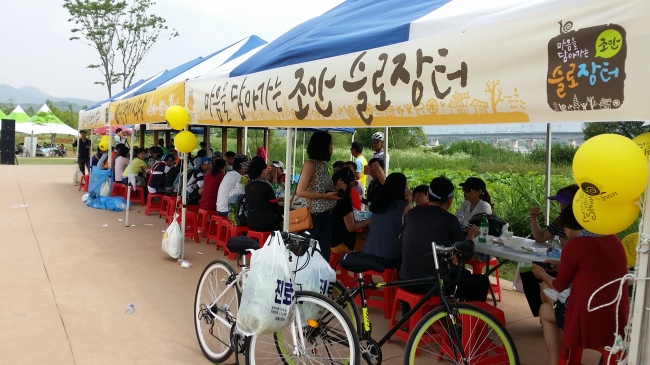Some people say that dating and eating have one thing in common: They can be fully enjoyed when you take them slow.
As far as eating is concerned, Koreans are beginning to discover the virtue of “slow food” ― sustainably produced foods that use regional ingredients adapted to the local environment. With this, locally produced foods are growing in popularity.
Jung Sung-hoon, 27, is among those who recently started to take interest in foods that are produced with care and are made with local and seasonal ingredients.
In fact, on June 14, he traveled from Seoul all the way down to Namyangju, Gyeonggi Province, in search of a bag of local, sustainably produced foods.
“It is good that I can taste the local farm products on the spot, learn about them and understand where they come from before making a purchase,” he told The Korea Herald, looking around the Joan Slow Market, a one-day outdoor market organized by the provincial city.
Jung was among nearly 3,800 visitors who came to the market that day, spending approximately 1.6 million won ($1,570) on organic vegetables, whole grains and other fresh local produce, city officials said.
 |
| Visitors look around the Joan Slow Market, a oneday outdoor market that sells local farm produce, held in Namyangju, Gyeonggi Province, on June 14. (The Joan Slow Market) |
The Joan market, launched that day as the country’s first slow food fair, will return every second Saturday of the month, they said.
The city took the initiative in Namyangju, but the slow food movement was originally a grassroots consumer campaign.
Started in mid-1980 by Carlo Petrini, it began as a rally against fast food and fast living, represented by international food giants such as McDonald’s.
Since then, it has evolved into a global movement involving millions of people in over 160 countries.
Its mission largely centers on preserving food diversity, building links between producers and consumers, and raising awareness about food through education, all to improve the quality of people’s lives.
It was in 2007 that the fad officially arrived in Korea, with the foundation of Slow Food Culture Center, a nonprofit organization.
The slow food movement is finally gaining momentum in Korea, as more Koreans yearn for a break from their fast-paced lives, said Lee Jong-duk, the Center’s president and sociology professor at Kyungnam University.
“Korean society was able to achieve rapid economic growth because the culture values quickness,” Lee told The Korea Herald.
“But after witnessing the side effects from such compressed development, Koreans now seek a slow life rather than fast life for their happiness and well-being,” he added.
In an indication of this growing interest, his center’s membership went from around 200 early last year to 500 this June.
The center runs various programs to promote locally produced food products and local culinary traditions.
One of them is the Ark of Taste, which catalogues the Korean foods at risk of extinction. Eight items, including the don tea and herbs from Ulleungdo Island, some 120 kilometers off the east coast, have already been added to the list.
“Koreans are losing their appetite for many traditional, local cuisines, with the surge of fast foods. We try to help them to understand that (we are) conserving the diversity of our foods to protect our agriculture, farmers and, in turn, ensure food security,” Kim said.
“It is not only us, but also our children who could be hit hard by the current way of eating. Every Korean should feel the responsibility for our future generations … And joining the slow food movement can be the first step,” Kim concluded.
By Ock Hyun-ju (laeticia.ock@heraldcorp.com)

